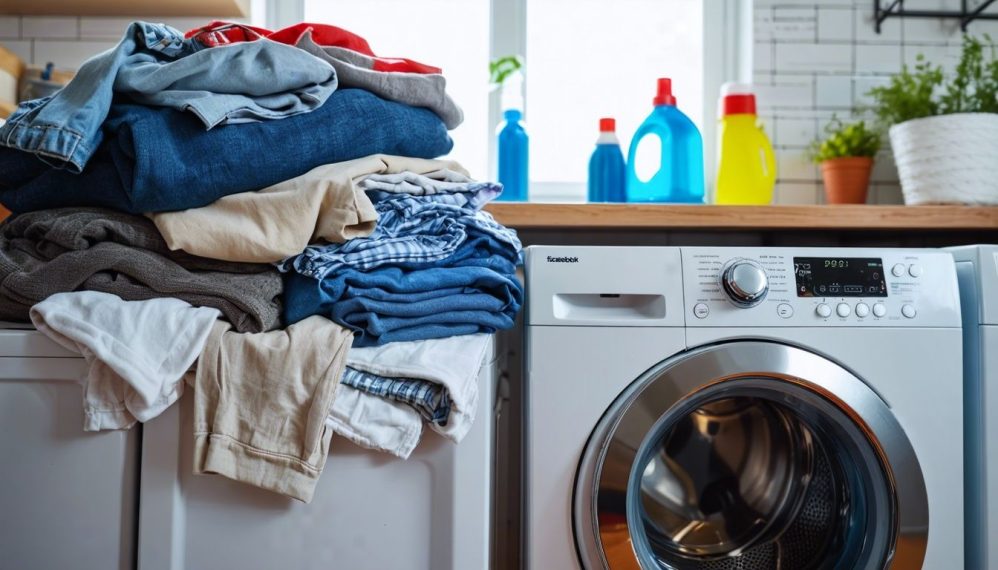
For allergy sufferers, maintaining a clean and allergen-free home is essential to minimize symptoms and improve overall health. One often overlooked area where allergens can accumulate is the laundry room. By following specific laundry practices, you can significantly reduce allergens in your clothes, bedding, and living environment. In this guide, we’ll explore essential tips and techniques to help you create an allergy-friendly laundry routine.
Key Takeaways
- Hot water washing above 130°F kills dust mites and removes allergens from fabrics, making it crucial for allergy sufferers.
- Using hypoallergenic, fragrance-free detergents and dryer sheets helps reduce skin irritation and allergic reactions.
- Regular cleaning of washers, dryers, and laundry areas prevents mold growth and allergen buildup.
- Washing new clothes before wearing removes chemicals and preservatives that can trigger allergies.
- Separating and washing allergen-prone items separately prevents cross-contamination of clean laundry.
Common Allergens in Laundry

Laundry can harbor various allergens that trigger reactions in sensitive individuals. Common culprits include dust mites, pollen, pet dander, and residues from harsh detergents or fabric softeners.
Chemicals, Fragrances, and Dyes
Chemicals, fragrances, and dyes in laundry products can trigger allergic reactions and skin irritation. Many detergents contain harsh substances that may cause rashes, itching, or respiratory issues for sensitive individuals. Common culprits include optical brighteners, fabric softeners, and artificial scents.
- Use ‘free and clear’ products to avoid skin reactions caused by fragrances, dyes, and detergents.
- Opt for hypoallergenic, scent-free detergents to minimize these risks. These products are typically free from dyes, perfumes, and phosphates—key irritants for allergy sufferers.
- Reading ingredient labels carefully ensures you choose laundry products that won’t exacerbate sensitivities or chemical allergies.
Dust Mites
Dust mites are microscopic creatures that thrive in warm, humid environments—especially bedding, upholstered furniture, and carpets. These tiny pests feed on dead skin cells and can trigger allergic reactions in sensitive individuals.
- Regular hot water washing is crucial for controlling dust mite populations. Washing clothes and bedding at temperatures above 130°F effectively kills all dust mites in the fabric.
- For optimal allergy management, bed sheets and pillowcases should be laundered at this temperature at least once a week. This practice not only eliminates dust mites but also removes allergens, helping to maintain a cleaner, more allergy-friendly sleeping environment.
Essential Laundry Tips for Allergy Sufferers

Essential laundry tips for allergy sufferers can make a world of difference in managing symptoms. These strategies help reduce allergens in your clothes and bedding, creating a healthier home environment.
Use Hot Water for Washing
Hot water is a powerful ally in the fight against allergens in laundry. Washing clothes and bedding at temperatures above 130°F effectively kills dust mites and removes allergens from fabric.
- Implementing hot water washing as part of your laundry routine can significantly reduce allergen exposure. For optimal results, focus on items that come into close contact with skin or collect dust easily.
- Remember, while hot water is effective, it’s not suitable for all fabrics—always check care labels before washing.
- Hot water is the secret weapon in your laundry arsenal against allergens and dust mites.
Use Anti-Allergen Detergent
After using hot water for washing, switch to an anti-allergen detergent. These specialized detergents are formulated without dyes or fragrances, reducing the risk of skin reactions.
- “Free and clear” products effectively clean clothes while minimizing potential irritants. Hypoallergenic options, often dermatologist-recommended, provide gentle yet thorough cleaning for sensitive skin.
- To maximize the benefits of anti-allergen detergents, consider an extra rinse cycle. This helps remove any lingering detergent residue that might cause irritation. Choose fragrance-free, dye-free laundry soaps to further minimize allergen exposure.
- These skin-friendly products maintain clothing cleanliness without compromising comfort for allergy sufferers.
Clean Washer and Dryer Regularly
Regular cleaning of your washer and dryer is crucial for allergy sufferers. Wipe down the inside of the washing machine and the dryer’s lint trap frequently. Run an empty wash cycle with a capful of bleach to eliminate allergens from the equipment.
- This simple routine helps maintain a hygienic laundry environment.
- Don’t forget the surrounding area. Clean the space around your washer and dryer with mold-killing sanitation wipes or a bleach-soaked washcloth. Mop walls and floors with disinfectant to create an allergy-free laundry zone.
- These steps effectively reduce allergen buildup and provide relief for allergy-prone individuals.
Avoid Outdoor Line Drying
Drying clothes outdoors can introduce allergens like pollen, dust, and mold spores into your clean laundry. Opt for indoor drying methods instead. Use your dryer on a low heat setting to minimize allergen exposure.
- If you don’t have a dryer, set up a drying rack in a well-ventilated room away from windows. This approach helps maintain the allergy-friendly state of your freshly washed clothes, keeping them free from outdoor irritants.
Wash New Clothes Before Wearing
Moving from outdoor drying concerns to another crucial step: washing new clothes before wearing. This practice isn’t just about freshness—it’s a key defense against allergens. New garments often contain chemicals, dyes, and preservatives that can trigger allergic reactions.
- Washing them before use removes these potential irritants, reducing the risk of skin issues and respiratory problems. It’s especially important for bedding, towels, and cloth napkins, which come into close contact with your skin.
- A quick pre-wash can make a significant difference in comfort and health for allergy sufferers.
Additional Tips for Reducing Allergens in Laundry
Managing allergies in the laundry room goes beyond basic washing techniques. These extra steps can make a big difference in reducing allergens and creating a healthier home environment.
Use Sensitive Skin and Hypoallergenic Products
Sensitive skin and hypoallergenic laundry products offer a gentle solution for allergy sufferers. These specialized cleaners are free from harsh chemicals, dyes, and fragrances that often trigger reactions.
- Opt for “free and clear” detergents—they’re designed to clean effectively without irritating skin or causing allergic responses.
- Dermatologist-recommended laundry detergents provide an extra layer of assurance for those with sensitive skin. These non-irritating formulas clean clothes thoroughly while minimizing the risk of rashes or itching.
- Paired with fragrance-free fabric softeners or dryer sheets, they create a comprehensive allergen-reducing laundry routine that keeps clothes clean and skin happy.
Utilize All-Free Clear Dryer Sheets
Moving from hypoallergenic products to dryer sheets, let’s explore a gentler option for fabric softening. All-free clear dryer sheets offer a chemical-free alternative to traditional fabric softeners.
- These sheets don’t contain harsh fragrances or dyes, making them ideal for those with sensitive skin or allergies. They’re effective at reducing static cling and softening clothes without leaving behind irritating residues.
- Opting for free and clear fabric softeners is crucial. Polyester dryer sheets coated in fabric-softener chemicals can cause skin irritation and allergic reactions. Instead, choose eco-friendly, non-toxic laundry care solutions that are both effective and gentle on your skin and clothes.
Separate Allergen-Prone Items
Keeping allergen-prone items separate is crucial for effective allergy management in laundry. Isolate heavily soiled clothes, pet bedding, and items exposed to outdoor allergens from other laundry.
- This prevents cross-contamination and reduces the spread of allergens to clean clothes. Use dedicated hampers or laundry bags for these items to maintain separation throughout the laundry process.
- Wash allergen-prone items separately using hot water and anti-allergen detergent. High temperatures help eliminate dust mites and other common laundry allergens. Regular cleaning of bed sheets and pillowcases at high temperatures, at least once a week, is essential for preventing dust mite irritation.
Vacuum and Dust Regularly
Separating allergen-prone items is just the first step. Regular vacuuming and dusting play a crucial role in reducing allergens throughout your home. Dust mites thrive in fabrics and carpets, making frequent cleaning essential.
- Aim to vacuum carpets and upholstery at least twice a week using a HEPA filter vacuum cleaner. This captures tiny particles effectively, preventing them from recirculating into the air.
- Dusting surfaces with a damp cloth or microfiber duster traps allergens instead of spreading them around. Pay extra attention to often-overlooked areas like ceiling fans, window sills, and baseboards.
- For optimal allergen control, consider wearing a mask while cleaning to avoid inhaling irritants. These simple yet effective habits significantly improve indoor air quality and minimize allergy triggers in your living space.
Keep a Clean Hamper
Maintaining a clean laundry area extends beyond just vacuuming and dusting. A clean hamper plays a crucial role in allergen control and mold prevention. Regularly wiping down the inside of your washing machine and the lint trap of your dryer helps prevent mold buildup in your hamper.
- This simple step goes a long way in reducing allergens and maintaining overall laundry room cleanliness.
- For thorough hamper maintenance, don’t forget the surrounding area. Use mold-killing sanitation wipes on the walls and floors around your washer and dryer. This practice enhances allergen reduction and contributes to a healthier laundry environment.
- By incorporating these habits into your routine, you’ll significantly improve your laundry space’s hygiene and minimize potential allergy triggers.
Conclusion
Implementing these laundry tips can significantly reduce allergens in your home, leading to better health and comfort for allergy sufferers. Dr. Amelia Thornton, a renowned allergist with over 20 years of experience, highlights the importance of hot water washing at 130°F to eliminate dust mites and the use of certified hypoallergenic products. She emphasizes creating a routine that includes washing bedding weekly in hot water and using allergen-proof covers on mattresses and pillows.
While these practices may increase energy costs due to hot water usage, Dr. Thornton asserts that the health benefits outweigh this drawback for those with allergies. These laundry tips provide a practical, science-based approach to reducing allergen exposure and improving quality of life for sensitive individuals.
FAQs
- What’s the best way to wash clothes to reduce allergens? Use hot water and a double rinse cycle to effectively remove allergens from clothing.
- Are there specific detergents for allergy sufferers? Yes, hypoallergenic and fragrance-free detergents are available for people with allergies.
- How often should I wash bedding to minimize allergens? Wash bedding weekly in hot water to keep allergens at bay.
- Can I use fabric softeners if I have allergies? It’s best to avoid fabric softeners, as they can irritate sensitive skin and trap allergens.
- What’s the ideal way to dry clothes for allergy sufferers? Dry clothes in a dryer on high heat or in direct sunlight to kill dust mites and other allergens.